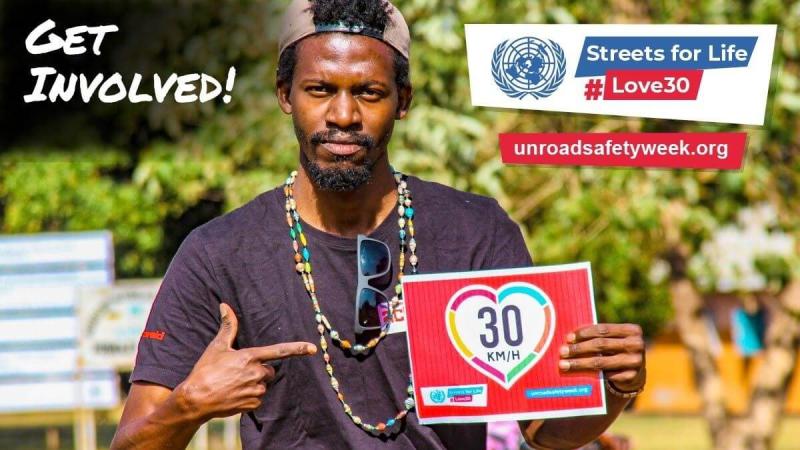

From protecting the pedestrians on African roads, ensuring effective post-crash response in Bangladesh, to giving safe access to schools in Paraguay, the UNRSF continues to leverage new financing and partnerships for road safety.
Ensuring that children in Paraguay have safer ways to get to and from schools; strengthening the medical post-crash response in Bangladesh; developing streets for safer and low-carbon mobility of pedestrians and cyclists in East Africa; and strengthening road safety data management and the design of impactful policies in the Arab region are some of the goals of the 10 new UNRSF projects.
To mark the launch of these new projects, the UNRSF has invited five well-known personalities from diverse backgrounds to discuss the main road safety challenges their countries are currently facing and to highlight the role advocacy can play to improve road safety. The virtual event "Safe and Sustainable mobility in developing countries", to be introduced by Jean Todt, the UN Secretary General’s Special Envoy for Road Safety and UNECE Executive Secretary Olga Algayerova, will take place on 15 October as a high-level side event of the Second United Nations Global Sustainable Transport Conference being held in Beijing, China. This event will be a unique occasion to listen to speakers from some of the countries where the new projects will be implemented, including Paraguayan journalist and UNICEF Ambassador, Mercedes Barriocanal; Rahman Rezaei, Former Iranian national football player; Sergey Ghahramanyan, Armenian Activist, founder of “Driver’s friend”.
According to Olga Algayerova, " the Second Decade of Action for Road Safety and its Global Plan is a new opportunity to put road safety at the heart of the SDG agenda". With more than 1.3 million deaths worldwide each year and nearly 50 million serious injuries, traffic crashes are the leading cause of death for young people between the ages of 5 and 29. Road traffic death rates remain unacceptably high in Africa and Southeast Asia where they surpass considerably the 18.2 per 100,000 population global average. In some African countries, the rate is as high as 31 per 100,000 population. By contrast, the average across countries of the Organization for Economic Cooperation and Development (OECD) is about 5 to 7 deaths per 100,000 population. In addition to the human loss, it costs countries 3-5% of their gross domestic product (GDP) keeping millions in poverty. "The clock to 2030 is ticking and we cannot afford to delay action", concludes the Executive Secretary of UNECE, which hosts the UN Road Safety Conventions.
The UNRSF was created in 2018 as an innovative partnership to directly support the achievement of two SDGs that address road safety (besides impacting a number of others): SDG target 3.6 on halving the number of global road deaths and injuries; and SDG target 11.2 on providing access to safe, affordable, accessible and sustainable transport systems for all. Today, the UNRSF has a portfolio of 25 projects, implemented by 11 UN agencies in 30 countries.
As detailed in its new results brochure, the Fund has provided hundreds of kilometers of safe walking and cycling lanes, supported the safer access to schools by children in multiple countries, and is incrementally working towards providing 400 million people with safer, cleaner vehicles. UNRSF projects are proofs of concepts of how road safety financing of proven interventions can save lives and reduce injuries. For example, in Brazil, through UNRSF financing, the road traffic rule enforcement system has been strengthened. resulting in a decrease in the rate of traffic deaths per 100,000 habitants from 17.03 in 2019 to 15.64 in 2020.
Despite the important progress towards improving road safety performance in developing countries, there remains a glaring challenge with mobilizing adequate levels of domestic and international financing.
The UNRSF currently receives contributions from the public sector, including the Russian Federation, France, the European Commission, the Kingdom of Bahrain, Monaco, Hungary, Slovakia, Cyprus and Mauritius, and from private sector companies such as FIA Foundation, Total Foundation, Michelin Corporate Foundation, Pirelli, 3M, Essilor, Keep Fighting Foundation and La Nuez Production. However, despite these and other sources of investments, the level of financing for road safety in developing countries is far lower than the current needs, especially in light of the ambitious Global Plan of Action for the Second Decade of Action on Road Safety (2021 – 2030). According to Nneka Henry, Head of the UNRSF Secretariat, “with an available budget of USD 4 million for the UNRSF 2020 Call for proposals, these 10 new projects, will scale the Fund’s ability to respond to increasing country demand for support to improve their national road safety performance.” Ms. Henry concluded by highlighting that “with country demand for UNRSF support exceeding USD 14 million in 2020, UNRSF was able to finance only one-third of country requests. With more country leadership and stronger partnership engagement, UNRSF will help governments to save many more lives in many more countries.”
Partnerships for a catalytic fund
Starting with country-led priorities and targeted results, UNRSF leverages the expertise of participating UN organizations and also crowds in a wide range of implementing partners to help governments achieve these results.
Through this collaborative approach, the UNRSF seeks to use its funding in a catalytic way, leveraging its unique position as a global UN fund to trigger further domestic and international investments, thus ensuring an impact far beyond its own grants. For example, there was an 83% increase, from 2019 to 2020, in projects that proposed co-funding arrangements and/or the recruitment of newly established national focal points on road safety. For instance, the project implemented by UNICEF in the Philippines targeting 100 high-risk schools as models in urbanized cities, will be scaled thanks to additional domestic financing. This is also the case with the project implemented by the United Nations Economic Commission for Africa (UNECA) and UNECE in Rwanda which will improve the government’s capacity to test and certify the safety of motorcycle helmets.
Originally published on https://roadsafetyfund.un.org